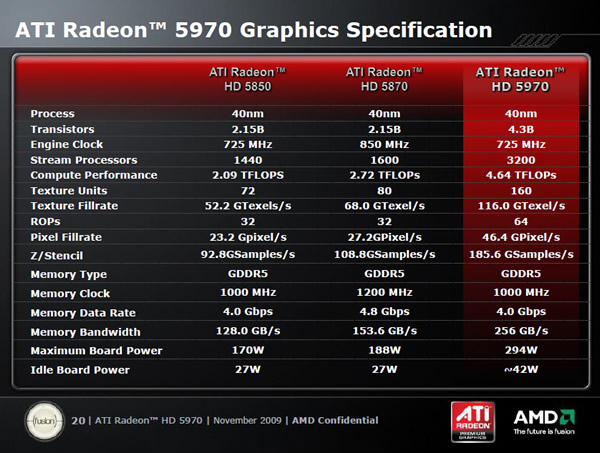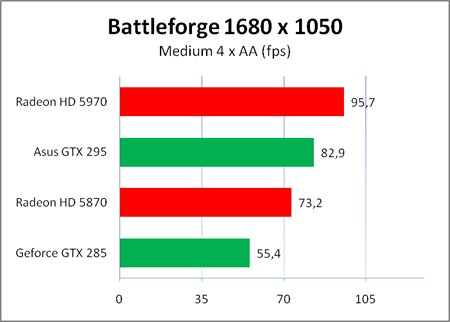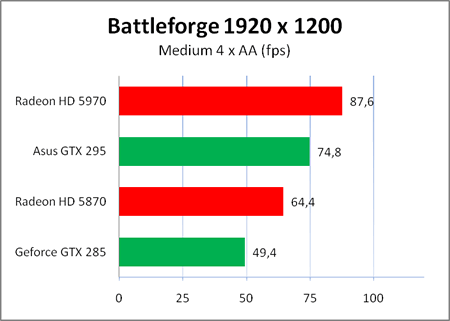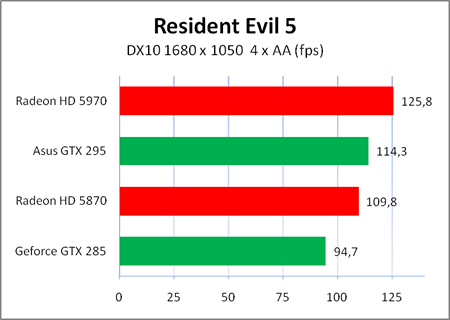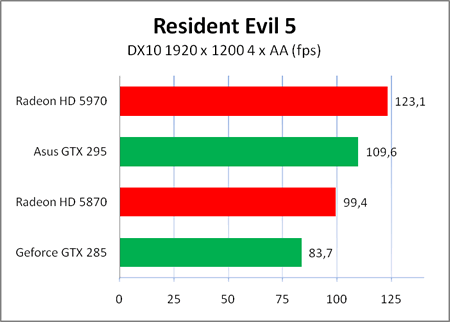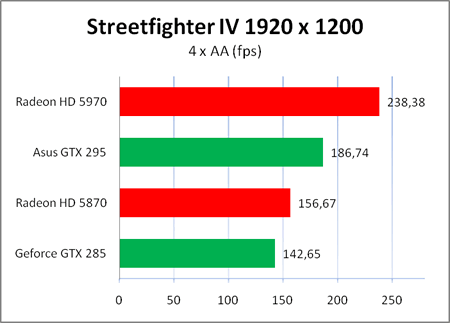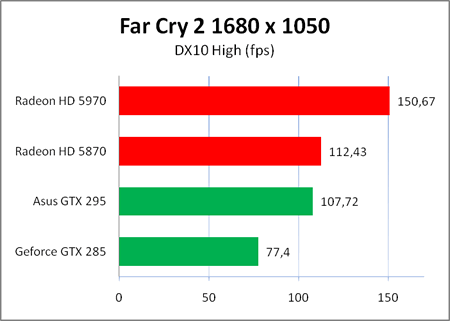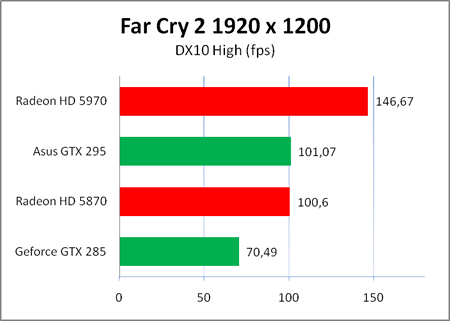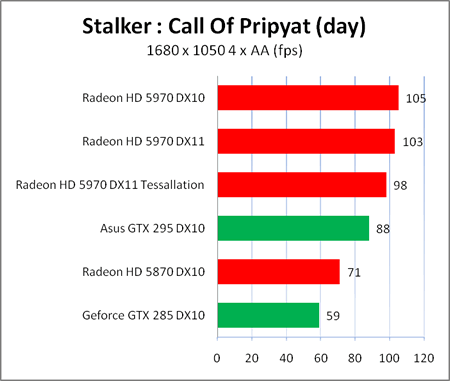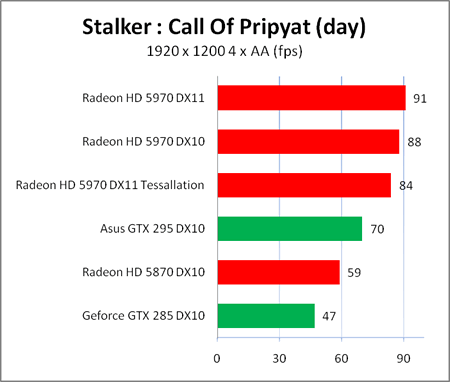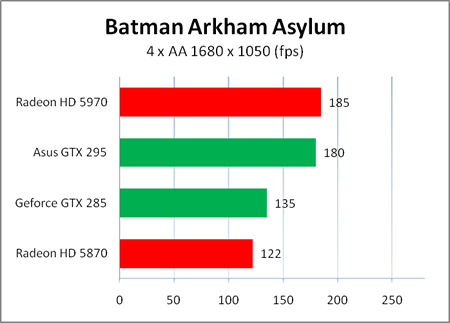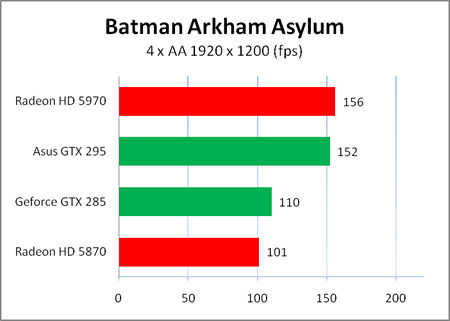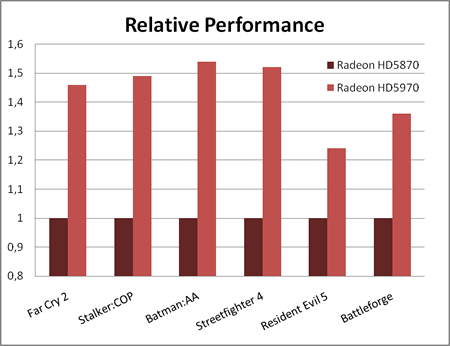AMD is calling the Radeon HD5970 the fastest video card available. We have pitted it against the GeForce GTX295 as well as compared it to the HD5870 to see if it is as good as AMD hopes.
INTRODUCTION
While we still are waiting for NVIDIA’s first DirectX 11-capable cards and probably will have to wait a few months into 2010 for them, AMD is getting busy releasing a steady stream of new cards to the consumers. When the HD5870 and the HD5850 was released AMDS spelled out their strategy and promised to follow up the cards first with the HD5770/HD5750 and then with the “Hemlock” card, the rumored HD5870X2. So far AMD has kept their promises and it is indeed the “Hemlock” that we are looking at today although the name has been changed to HD5970.
We have been used to AMD talking a lot about having the best performance/price ratio and indeed a lot of their success lately has come from the fact that they have had affordable cards with great performance. With the HD5970 however AMD am using a different tune. The HD5970 is marketed as the fastest video card currently available by a large margin and a card where AMD has gone out of their way to create the best possible video card for the enthusiast with lots of headroom for overclocking. Forget cheap and affordable. The HD5970 takes on the GTX295 at its own turf with a price around $500.
Is AMD getting overconfident? Are these promises just regular marketing hype? Read on to hear our take on the HD5970, the largest video card that we have seen so far.
SPECIFICATIONS
Some of you probably wonder why this card is called HD5970 instead of HD5870X2? When asked this question during one of their briefings AMD danced around the question by saying that they felt the HD5970 was a “class of its own”. The truth of course is that the specifications of the HD5970 are a mix of the HD5850 and the HD5870. Naming it either HD5850X2 or HD5870X2 simply would not be true. While it has double the Stream Processors and Texture Units of the HD5870 the clockspeed of the GPU and the memory is instead the same as the HD5850. It still is a beast though and you get a whopping compute performance of 4.64 TFLOP’s from one of these cards.
Even though this is a dual-GPU-card it only draws about 42W of power when in idle mode. AMD has managed this by improving their power saving method “ATI Powerplay” so that it puts one of the GPU’s in sleep mode when it is not needed. AMD compared this to the C1-state of the CPU. As we put a full load on the card the power consumption rises dramatically and it tops out at around 294W which is just at the edge of what a 6-pin and an 8-pin power connector can give (300W). It is a deliberate choice from AMD to stay under 300W as they would limit the customer base if they required two 8-pin connectors. OEM’s though are free to use an 8-pin instead of a 6-pin connector and AMD was quick to stress that there still was no problems when overclocking even though you would technically use more power than the connectors was speced for.
AN ENTHUSIAST CARD
It takes just one look to figure out that the HD5970 is a very special card. This is a long card, a very long card. At 30 cm the card won’t fit in many cases and AMD said that they aim it at the Full Tower cases. When asked why they made such a long card the answer was simply that they decided not to limit themselves when building the best possible card and as they needed the card to be this long they made it so long even if it makes it less usable in regular cases.
According to AMD the GPU’s used in the HD5970 are screened so that only the “Low leakage Premium ASICs” is being used. Let’s just called it fancy words for “GPU’s that overclock well”. Because if it is one thing AMD want us to do it is to overclock the HD5970.
AMD has uncapped the AMD Overdrive limit so that you can take this card from 725 MHz all the way up to 1 GHz. The memory on the other hand can go from 1000 MHz up to 1500 MHz. AMD was quick to point out that each card will behave differently but they promise a lot of headroom in the overclocking department. In fact they even included a Voltage Overdrive utility for us reviewers which allows us to increase the voltage on the card to achieve even higher overclocks. This utility will not be available for end-users but have been made available for the OEM’s so that they can hook it into their utilities.
To make sure that all the heat from the overclocking is vented out properly AMD has equipped the HD5970 with a Vapor Chamber cooler that can take care of up to 400W of generated heat.
AMD has not spared the rest of the components and the card comes with a Multi-Point programmable PWM fan controller, pure ceramic supercapacitors, digital programmable volterra regulators and real time power monitoring.
The HD5xxx have spoilt us with the choice of display connectors. The HD5970 oddly enough comes with far less connectors. All we get is 2 DVI-D connectors as well as one mini-DisplayPort connector. The reason behind this is again the goal to offer the best possible performance of the card. To get the best possible ventilation AMD needs half of the backplate for the air-vent and thus they are forced to make due with the space that is left for their connectors. AMD will however supply the card with a DVI => HDMI adapter as well as a mini-DisplayPort => standard DisplayPort adapter.
Enough talk about the card and the specifications. It is time to see how it performs.
PERFORMANCE – THIS IS HOW WE TESTED IT
We usually get a reference card from AMD so that we can do our own testing but this time the supply has been very limited. We therefore decided to work together with our colleague Öjvind Karlsson at Mikrodatorn in Sweden (http://mikrodatorn.idg.se) and share the results he got since he actually is currently using the card that we will get in a few days.
The system used for this review was:
- CPU: Core i7 965 (3,2 GHz)
- Cooler: Intel
- Motherboard: MSI Eclipse Plus
- Memory: Patriot Viper 3 x 2 GB PVT36G1600LLK
- PSU: Coolermaster Real Power (1250 W)
- Monitor: Benq G2400WD
- OS: Windows 7 32-bit (which unfortunately means we are not using the full 6 GB)
- Driver: AMD Catalyst 8.663.1 Beta4 and Geforce 191.07
We measured the performance in 6 games and as far as possible used the in-built benchmark functions.
Power consumption was measured at the wall. This measures the power consumption of the whole system excluding the monitor. Low load was measured while the system was idle at the windows desktop and high load was measured while running FurMark 1.7.0 for 15 minutes. Temperature readings were done with MSI Afterburner and FurMark 1.7.0 was also used here.
BATTLEFORGE
This is one of the few DX11-capable games currently available. The game is a mix between RTS and card game.
Right off the bat the HD5970 takes a lead over the GTX295. The Battleforge engine has always favoured AMD and thus as expected we see that the HD5870 also wins over the GTX285.
Even as we increase the resolution the HD5970 still holds the lead.
RESIDENT EVIL 5
Again the HD5970 comes out on top.
At the higher resolution the HD5870 beats the GTX285 and the HD5970 beats the GTX295. A win on all counts for AMD.
STREETFIGHTER IV
Streetfigher 4 is a game that excels on the AMD video cards. We get a whopping 30% more frames per second than the GTX295. Not that it really matters if we play at 186 or 238 fps but it at least shows the power of the video card.
Far Cry 2
Far Cry 2, released in October 2008 by Ubisoft, was one of the most anticipated titles of the year. It’s an engaging state-of-the-art First Person Shooter set in an un-named African country. Caught between two rival factions, you’re sent to take out “The Jackal”. Far Cry2 ships with a full featured benchmark utility and it is one of the most well designed, well thought out game benchmarks we’ve ever seen. One big difference between this benchmark and others is that it leaves the game’s AI (Artificial Intelligence) running while the benchmark is being performed.
The engine of Far Cry 2 runs very well on the AMD cards. Notable is that even the HD5870 manages to beat the GTX295.
Even at the higher resolution we get the same result. In fact, it looks like we are getting CPU-limited at this setting since there isn’t much difference between 1680×1050 and 1920×1200. As soon as we get our hands on our own video card we will test the cards at the Ultra High setting.
STALKER: CALL OF PRIPYAT
This is a new chapter in the Stalker-series which now comes with full DX11-support. We used a benchmark-tool which runs through the game in various settings.
Regardiless if we use DX10, DX11 or DX 11 with Tesselation the HD5970 manages to beat all the other cards.
As expected there is no change when we increase the resolution.
BATMAN: ARKHAM ASYLUM
Surprisingly this is a really good Batman-game with excellent graphics and real good gameplay. The game uses the UNreal 3-engine and NVIDIA has been helping the developer making sure that this is one of the games that is used to show off what PhysX can do. AA cannot be turned on inside the game for AMD-cards and instead needs to be set in the Catalyst controlpanel. We also ran into a problem with the GTX295 where we had to turn off PhysX in the NVIDIA control panel to get it to run at full speed inside the game. It seems the second GPU otherwise was reserved for PhysX even though we did not turn off PhysX inside the game. During this testing PhysX hardware support was turned off.
The HD5970 just barely manages to beat the GTX295.
No change as we move up in the resolution. The NVIDIA cards of course has a clear edge in the game as they allow us to turn on PhysX and, albeit with reduced framerates, play the game with nicer graphics with lots of cool effects.
RELATIVE PERFORMANCE VERSUS GTX295 AND HD5870
To get a better overview on how much faster the HD5970 is than the GTX295 and the HD5870 we’ve created two charts where the performance of the GTX295 and HD5870 respectively has been set to 1. The results at the highest tested setting were used. To see what these were for each game head to their specific page in this article.
With the exception of Batman: Arkham Asylum the HD5970 is beating the GTX295 comfortably in every game.
The performance is scaling very nicely from the single-GPU HD5870 to the dual-GPU HD5970.
POWER CONSUMPTION
The power consumption was measured at the wall and excludes the monitor.
At idle/low load the HD5970 manages to draw 17W less than the GTX295. When we load the card with FurMark the HD5970 instead draws 13W more. In the end it is interesting to see that even with a Core i7 CPU and one of these expensive and power hungry cards we still do not break 500W at the wall. If we want to stay below 80% usage when the system is fully loaded it means we still can get away with a 600-650W powersupply.
SOUND LEVEL
The sound level was measured at 1 meter distance.
Neither of the cards are especially silent and the HD5970 is marginally worse than the ASUS GTX295.
TEMPERATURES
The temperatures were measured with MSI Afterburner.
There isn’t much difference between the two cards and both the GTX295 and the HD5970 get hot when put under full load. The coolers though are set up to handle the heat so it should not be a problem.
CONCLUSION

- The fastest cards at almost every price point
- DirectX 11 capable cards at almost every price point
The only cards missing now are the very low end cards which we should see beginning next year.
The Radeon HD5970 is an amazing card. The raw power that the card has should be enough to last for quite some time before needing an upgrade. Since we still are waiting for our own card we could not test the overclocking potential but if AMD holds it promises it is an indication that there is even more headroom available on the card making it possible to release a higher speced version in time for NVIDIA’s Fermi-launch next year.
The downside of the card is of course the price, MRSP is $500, and the fact that it is 30 cm long making it hard to fit in most cases. It is however an enthusiast card for the hard core gamers and while the price is high it is actually about the same as the GTX295 which means that NVIDIA needs to lower their prices to keep the GTX295 competitive.
So when do we get to buy this card? AMD was very clear on that this should be a hard launch meaning that there should be limited supplies in stores today but we did a quick search in some of the online e-tailers in the US and Sweden and couldn’t find any who even had it in their system so it probably will take a few days/a week or so for supply to start building up. At the HD5970 briefing AMD admitted that there had been problems with the 40nm process and that the yields were lower than expected but that these issues were taken care of and that supplies of all 40 nm HD5xxx GPU:s were ramping up. Hopefully this means more HD5850, HD5870 and HD5970 in the stores very soon.
A big thank to Öjvind at http://mikrodatorn.idg.se for sharing his results with us. You can all look forward to more reviews of retail cards in the coming days/weeks as well as some more in-depth testing of the overclocking capabilities of this card as soon as we have cards in-house.
 Bjorn3D.com Bjorn3d.com – Satisfying Your Daily Tech Cravings Since 1996
Bjorn3D.com Bjorn3d.com – Satisfying Your Daily Tech Cravings Since 1996

